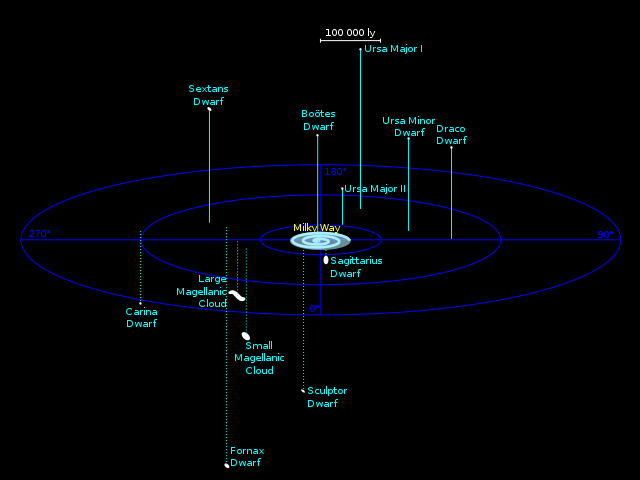The Milky Way Galaxy has about 26 associated satellite galaxies, which is strange to imagine, since we think of a galaxy as a massive collection of Billions of stars. The dwarf galaxies are not easily visible since they are small, so they tend to blend in with the background of Milky Way stars that are much closer.
You might also notice from the above image that the dwarf galaxies are distant, lying beyond the 100,000 light year scope of our large spiral home. Most of them likely originated in the turmoil of protogalaxy collisions that occurred billions of years ago, which led to the formation of the Milky Way. The leftover stars that didn’t end up in the main galaxy clumped together to give us a series of smaller dwarf galaxies, many of which are like medium to large sized star clusters.
According to a new study from the Rochester Institute of Technology, a small cluster of young Cepheid variable stars has been observed in the outer disk of the Milky Way, representing the normal matter in a dwarf galaxy dominated by dark matter, and hidden behind the gas clouds of the galactic disk. Data from the near-infrared VISTA instrument at the European Southern Observatory allows astronomers to peer through the dusty plane of the Milky Way, and has seen a group of four Cepheid variable stars approximately 300,000 light years away.

Team leader Sukanya Chakrabarti predicted the existence of a dwarf galaxy in the region in 2009, based on her analysis of gravitational ripples in the outer disk of the Milky Way. The discovery of the Cepheid variables shows that our method of finding the location of dark-matter dominated dwarf galaxies works,” she said. “It may help us ultimately understand what dark matter is made up of. It also shows that Newton’s theory of gravity can be used out to the farthest reaches of a galaxy, and that there is no need to modify our theory of gravity.”
The stars were well beyond the end of the Milky Way’s disk, which fades around 50,000 light years from its centre. So how do we know that the stars in this dark dwarf galaxy are 300,000 light years distant?
The answer lies in a fascinating property of Cepheid variable stars. I was lucky enough to study this principle while doing a research project during my undergraduate studies. It’s called the period-luminosity relation, and states that the period of brightening and dimming of a Cepheid variable star is directly related to its intrinsic luminosity. By measuring the period of the stars variance, we can determine exactly how bright it is. And then once we look at how bright it appears from Earth, we can calculate it’s distance quite accurately.
A good analogy is looking at a lightbulb off in the distance. It doesn’t look all that bright, but if we knew it was a 40-Watt bulb, we could calculate how far away it is, since we know how the brightness of a light changes with distance. It’s exactly the same with stars. We know how their brightness (magnitude) changes with distance. So if we can find the surface brightness (luminosity) of a star, we can calculate its distance. We can find the distance to most stars using their colour and subsequently their temperature, known as Stefan’s Law.
The reason Cepheid variables are so valuable, is that they are among the brightest stars in the sky, and can be seen in other galaxies, while smaller stars are dimmer and its more difficult to determine their colour for Stefan’s Law.
So there you have it, a dark galaxy and a bit of an understanding of stellar distances. It will be interesting to see how many Dark Matter dominated galaxies there are in the local group. We will also see more amazing results from VISTA, as it peers through the dusty galaxy to observe what we previously could not.

